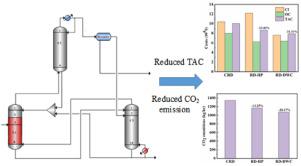Chemical Engineering and Processing: Process Intensification ( IF 3.8 ) Pub Date : 2021-11-30 , DOI: 10.1016/j.cep.2021.108746 Xiaoxin Gao 1, 2 , Yi Yang 2 , Mengyuan Chen 2 , Qiuran Cheng 2 , Kairui Lu 2

|
Focusing primarily on the issue of high energy consumption in isopropyl acetate (IPAC) production, a heat pump reactive distillation (RD-HP) process and a dividing-wall column reactive distillation (RD-DWC) process were proposed. Chemical software Aspen Plus (version 10) was used to investigate the steady state simulations. In this work, RD-HP and RD-DWC processes were compared with conventional reactive distillation (CRD) in energy saving, economic, and environmental performance. In addition, TAC was used as the objective function, and the sequential iterative procedure was proposed for the design of three processes, and the optimal parameters were obtained. The results manifested that the IPAC product of three processes all reached the purity index (mole fraction 98.20%). Compared with CRD, the TAC of RD-HP and RD-DWC were reduced by 13.46% and 21.31%, CO2 emissions were reduced by 13.25% and 20.17%, respectively. The thermodynamic efficiency of three processes are 7.69%, 9.02%, and 10.57%, respectively.
中文翻译:

用于合成乙酸异丙酯的新型热泵反应精馏和隔壁塔反应精馏工艺以节省 TAC 并减少 CO2 排放
主要针对醋酸异丙酯(IPAC)生产能耗高的问题,提出了热泵反应精馏(RD-HP)工艺和间壁塔反应精馏(RD-DWC)工艺。化学软件 Aspen Plus(版本 10)用于研究稳态模拟。在这项工作中,RD-HP 和 RD-DWC 工艺与传统反应蒸馏 (CRD) 在节能、经济和环境性能方面进行了比较。此外,以TAC为目标函数,对三个过程的设计提出了顺序迭代程序,得到了最优参数。结果表明,三种工艺的IPAC产品均达到纯度指标(摩尔分数98.20%)。与CRD相比,RD-HP和RD-DWC的TAC降低了13。2排放量分别减少了13.25%和20.17%。三个过程的热力学效率分别为7.69%、9.02%和10.57%。







































 京公网安备 11010802027423号
京公网安备 11010802027423号